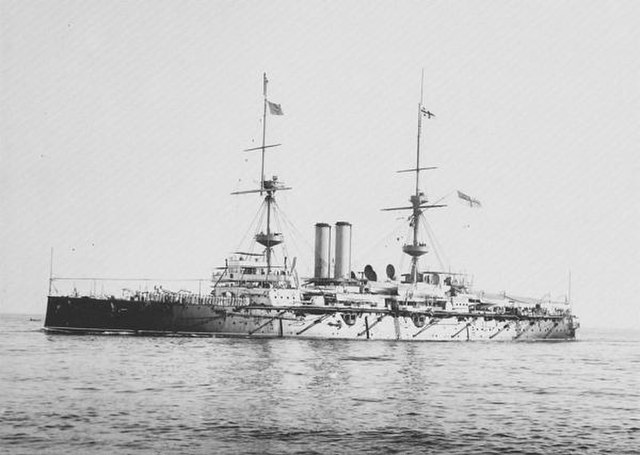Royal Sovereign-class battleship
The Royal Sovereign class was a group of eight pre-dreadnought battleships built for the Royal Navy in the 1890s. The ships spent their careers in the Mediterranean, Home and Channel Fleets, sometimes as flagships, although several were mobilised for service with the Flying Squadron in 1896 when tensions with the German Empire were high following the Jameson Raid in South Africa. Three ships were assigned to the International Squadron formed when Greek Christians rebelled against the Ottoman Empire's rule in Crete in 1897–1898.
The high-freeboard Royal Sovereign underway in a moderate sea
Right elevation, deck plan and hull section as depicted in Brassey's Naval Annual 1906
The low-freeboard Hood equipped with turrets
The barbette-equipped Empress of India
Pre-dreadnought battleship
Pre-dreadnought battleships were sea-going battleships built from the mid- to late- 1880s to the early 1900s. Their designs were conceived before the appearance of HMS Dreadnought in 1906 and their classification as "pre-dreadnought" is retrospectively applied. In their day, they were simply known as "battleships" or else more rank-specific terms such as "first-class battleship" and so forth. The pre-dreadnought battleships were the pre-eminent warships of their time and replaced the ironclad battleships of the 1870s and 1880s.
HMS Royal Sovereign (1891) was the first pre-dreadnought battleship of the Royal Navy.
HMS Ocean was typical of pre-dreadnought battleships
HMS Dreadnought shows the low freeboard typical for early ironclad turret-ships. This ship, launched in 1875, should not be confused with her famous successor, launched in 1906, marking the end of the pre-dreadnought era.
HMS Ramillies was the fourth ship of the influential Royal Sovereign class. The diagonal tubes are spars for torpedo nets.








